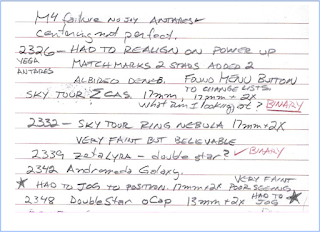It is a poor workman who blames his tools. For all of the problems with the Celestron AVX mount and tripod recorded here last month, from the first night, as soon as it was aligned, it served as a teaching aid, modeled on a mentor rather than a book. Books are necessary for their factual expositions, but they do not work well in the dark. This does.
 |
| A citizen scientist always keeps a lab notebook. |
When setting up the new mount, I checked the computer against targets that I know, such as the double stars Albireo and eta Cassiopeia and the globular cluster Messier 22 in Sagittarius. I also tested with choices that I did not know. All of this involved learning the menu system by night and re-reading the user manual during the day. The mount has a database with over 40,000 objects available in two presentations: Identify (keypad 4) and Object Info (keypad 0).
 |
| Two refractors. "Grab and go" 102-mm (4 inch) doublet (12 lbs) above new 115-mm (4.5 inch) triplet (17 lbs) below |
The new instrument is an Astro-Tech 115-mm extremely-low dispersion (ED) rare earth glass apochromatic (APO) triplet telescope. It is somewhat larger and more refined than my “grab and go” an Explore Scientific 102-mm achromatic doublet. In addition, I acquired two high-value oculars (“eyepieces”), a TeleVue 7-mm and a Meade 14-mm. Both offer 82 degrees of view and quality lens coatings. Obviously, the larger the objective and the better the glass, the more you see.
 |
| A citizen scientist always keeps a lab notebook. |
That said, the primary factor is the sky: good seeing trumps good glass. I live in the city and my sky is Bortle 7-8 meaning that the Milky Way is not visible naked eye. So, at the end of two weeks’ work, I packed up the mount and tripod and the telescope and will take them all out again after we move early next year.
Listed here are just the first views of stars and deep space objects (DSOs). I recorded other views and also tested a different telescope (returned to vendor) on known targets.
8 September
2047 hours – 17 Cygni binary
2326 hours – sigma Cassiopeiae binary
2332 hours – Messier 57 the Ring Nebula (very faint but acceptable)
2339 hours – zeta Lyrae binary
2348 hours – omicron Capricorni binary
09 September
2257 hours – Messier 54, Messier 69, Messier 70 all in Sagittarius in quick succession, all faint but acceptable.
Continuing – Messier 11 in Scutum, Messier 27 in Sagitta, 61 Cygni binary.
2341 – failures on known objects; first eta Cassiopeiai and then Polaris. Had to use the handset (paddle) to slue the telescope (jog the robot) to the target. Powered down and re-aligned. Resumed sky tour of known objects.
10 September
02:31 hours – Jupiter far off center. Powered down and quit for the night.
11 September
2051 hours – Messier 13 in Hercules.
2105 hours – Messier 6 and Messier 7 (already known to me as the Ptolemy Cluster)
16 September
2120 hours Messier 13 in Hercules (good viewing)
2248 hours – Messier 17, Messier 21, Messier 25
05 October
2017 hours – Algieda (alpha Capricorni) triple star
2020 hours –Dabih (beta Capricorni) binary
09 October – with the expensive kit and gear all back in their boxes and cartons, I went out with my 70-mm National Geographic refractor and two entry-level Celestron (“First Scope”) eyepieces and viewed Jupiter, Messier 22, Algiedi and Dabih. Better glass is a better view, but the best telescope is the one that gets used.
PREVIOUSLY ON NECESSARY FACTS
New Telescope: Explore First Light 102-mm Refractor
Redshift: Six Years with Astronomy
Backyard Astronomy (13 June 2020)
Backyard Astronomy (4 July 2017)
No comments:
Post a Comment
Note: Only a member of this blog may post a comment.